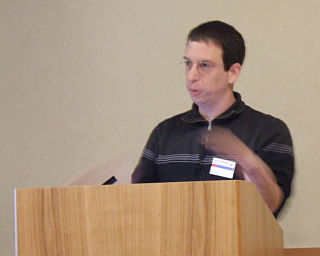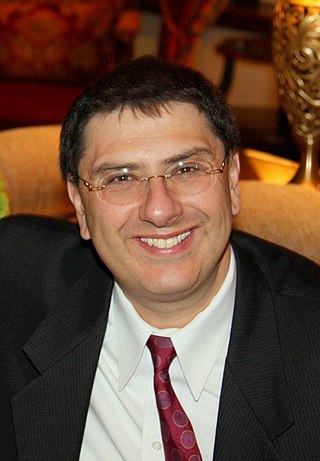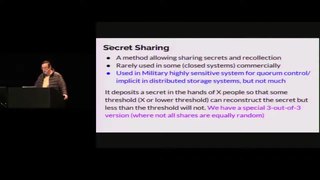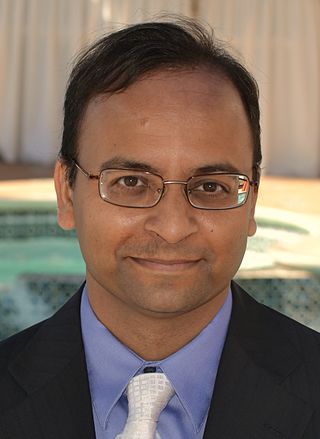In cryptography, key size or key length refers to the number of bits in a key used by a cryptographic algorithm.

In cryptography, encryption is the process of transforming information in a way that, ideally, only authorized parties can decode. This process converts the original representation of the information, known as plaintext, into an alternative form known as ciphertext. Despite its goal, encryption does not itself prevent interference but denies the intelligible content to a would-be interceptor.

Public-key cryptography, or asymmetric cryptography, is the field of cryptographic systems that use pairs of related keys. Each key pair consists of a public key and a corresponding private key. Key pairs are generated with cryptographic algorithms based on mathematical problems termed one-way functions. Security of public-key cryptography depends on keeping the private key secret; the public key can be openly distributed without compromising security. There are many kinds of public-key cryptosystems, with different security goals, including digital signature, Diffie-Hellman key exchange, public-key key encapsulation, and public-key encryption.
In cryptography, a brute-force attack consists of an attacker submitting many passwords or passphrases with the hope of eventually guessing correctly. The attacker systematically checks all possible passwords and passphrases until the correct one is found. Alternatively, the attacker can attempt to guess the key which is typically created from the password using a key derivation function. This is known as an exhaustive key search. This approach doesn't depend on intellectual tactics; rather, it relies on making several attempts.

Ronald Linn Rivest is an American cryptographer and computer scientist whose work has spanned the fields of algorithms and combinatorics, cryptography, machine learning, and election integrity. He is an Institute Professor at the Massachusetts Institute of Technology (MIT), and a member of MIT's Department of Electrical Engineering and Computer Science and its Computer Science and Artificial Intelligence Laboratory.
In cryptography and steganography, plausibly deniable encryption describes encryption techniques where the existence of an encrypted file or message is deniable in the sense that an adversary cannot prove that the plaintext data exists.
In cryptography, a private information retrieval (PIR) protocol is a protocol that allows a user to retrieve an item from a server in possession of a database without revealing which item is retrieved. PIR is a weaker version of 1-out-of-n oblivious transfer, where it is also required that the user should not get information about other database items.
Encryption software is software that uses cryptography to prevent unauthorized access to digital information. Cryptography is used to protect digital information on computers as well as the digital information that is sent to other computers over the Internet.
A deterministic encryption scheme is a cryptosystem which always produces the same ciphertext for a given plaintext and key, even over separate executions of the encryption algorithm. Examples of deterministic encryption algorithms include RSA cryptosystem, and many block ciphers when used in ECB mode or with a constant initialization vector.

Dan Boneh is an Israeli–American professor in applied cryptography and computer security at Stanford University.

Rafail Ostrovsky is a distinguished professor of computer science and mathematics at UCLA and a well-known researcher in algorithms and cryptography.
In cryptography, a hybrid cryptosystem is one which combines the convenience of a public-key cryptosystem with the efficiency of a symmetric-key cryptosystem. Public-key cryptosystems are convenient in that they do not require the sender and receiver to share a common secret in order to communicate securely. However, they often rely on complicated mathematical computations and are thus generally much more inefficient than comparable symmetric-key cryptosystems. In many applications, the high cost of encrypting long messages in a public-key cryptosystem can be prohibitive. This is addressed by hybrid systems by using a combination of both.

Mordechai M. "Moti" Yung is a cryptographer and computer scientist known for his work on cryptovirology and kleptography.
Jonathan Katz is a professor in the Department of Computer Science at the University of Maryland who conducts research on cryptography and cybersecurity. In 2019–2020 he was a faculty member in the Volgenau School of Engineering at George Mason University, where he held the title of Eminent Scholar in Cybersecurity. In 2013–2019 he was director of the Maryland Cybersecurity Center at the University of Maryland.

Amit Sahai is an Indian-American computer scientist. He is a professor of computer science at UCLA and the director of the Center for Encrypted Functionalities.
Crypto-shredding is the practice of rendering encrypted data unusable by deliberately deleting or overwriting the encryption keys: assuming the key is not later recovered and the encryption is not broken, the data should become irrecoverable, effectively permanently deleted or "shredded". This requires that the data have been encrypted.

Private set intersection is a secure multiparty computation cryptographic technique that allows two parties holding sets to compare encrypted versions of these sets in order to compute the intersection. In this scenario, neither party reveals anything to the counterparty except for the elements in the intersection.

Searchable symmetric encryption (SSE) is a form of encryption that allows one to efficiently search over a collection of encrypted documents or files without the ability to decrypt them. SSE can be used to outsource files to an untrusted cloud storage server without ever revealing the files in the clear but while preserving the server's ability to search over them.

Hugo Krawczyk is an Argentine-Israeli cryptographer best known for co-inventing the HMAC message authentication algorithm and contributing in fundamental ways to the cryptographic architecture of central Internet standards, including IPsec, IKE, and SSL/TLS. In particular, both IKEv2 and TLS 1.3 use Krawczyk’s SIGMA protocol as the cryptographic core of their key exchange procedures. He has also contributed foundational work in the areas of threshold and proactive cryptosystems and searchable symmetric encryption, among others.
Structured encryption (STE) is a form of encryption that encrypts a data structure so that it can be privately queried. Structured encryption can be used as a building block to design end-to-end encrypted databases, efficient searchable symmetric encryption (SSE) and other algorithms that can be efficiently executed on encrypted data.









